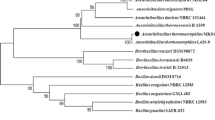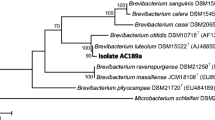Abstract
In the present work, biosurfactant production of the bacterial strain Stenotrophomonas sp. IE-93 was surveyed and quantified through four conventional screening methods. The biosurfactant produced by the strain IE-93 could reduce the surface tension to 24 mN m−1 and showed 100% emulsification activity when equal volume of n-hexane and fermentation medium was applied. Effects of culture conditions on productivity of the strain revealed that olive oil and ammonium sulfate were the best carbon and nitrogen sources, respectively. The crude produced biosurfactant showed a good stability during exposure to high temperatures (up to 120 °C), high salinity (up to 20% NaCl) and a wide range of pHs (2.0–12.0). Purification of the biosurfactant was performed using ethyl acetate, and crude extract was separated on silica gel column chromatography. The chemical characterization of the purified biosurfactant by FTIR spectroscopy revealed that it has a lipopeptide nature. Moreover, ultraviolet mutation of Stenotrophomonas sp. IE-93 yielded a stable mutant that produced over 1.7-fold more of the biosurfactant than the parent strain. Overall, the results suggest that Stenotrophomonas sp. IE-93 could be suitable candidate to use in various industrial processes needing emulsifier, especially in oil industry which needs a stable surfactant in high temperature and salinity conditions.






Similar content being viewed by others
References
Abu-Ruwaida A, Banat I, Haditirto S, Khamis A (1991) Nutritional requirements and growth characteristics of a biosurfactant-producingRhodococcus bacterium. World J Microbiol Biotechnol 7:53–60
Amiriyan A, Assadi MM, Saggadian V, Noohi A (2004) Bioemulsan production by Iranian oil reservoirs microorganisms. J Environ Health Sci Eng 1:28–35
Andrade Silva NR, Luna MA, Santiago AL, Franco LO, Silva GK, de Souza PM, Okada K, Albuquerque CD, Silva CA, Campos-Takaki GM (2014) Biosurfactant-and-bioemulsifier produced by a promising Cunninghamella echinulata isolated from caatinga soil in the northeast of Brazil. Int J Mol Sci 15:15377–15395
Banat IM (1995) Biosurfactants production and possible uses in microbial enhanced oil recovery and oil pollution remediation: a review. Biores Technol 51:1–12
Bezza FA, Chirwa EMN (2015) Production and applications of lipopeptide biosurfactant for bioremediation and oil recovery by Bacillus subtilis CN2. Biochem Eng J 101:168–178
Bouassida M, Ghazala I, Ellouze-Chaabouni S, Ghribi D (2018) Improved biosurfactant production by Bacillus subtilis SPB1 mutant obtained by random mutagenesis and its application in enhanced oil recovery in a sand system. J Microbiol Biotechnol 28:95–104
Bustamante M, Durán N, Diez M (2012) Biosurfactants are useful tools for the bioremediation of contaminated soil: a review. J Soil Sci Plant Nut 12:667–687
Dadrasnia A, Ismail S (2015) Biosurfactant production by Bacillus salmalaya for lubricating oil solubilization and biodegradation. Int J Environ Res Public Health 12:9848–9863
Deleu M, Razafindralambo H, Popineau Y, Jacques P, Thonart P, Paquot M (1999) Interfacial and emulsifying properties of lipopeptides from Bacillus subtilis. Colloids Surf A Physicochem Eng Asp 152:3–10
Desai JD, Banat IM (1997) Microbial production of surfactants and their commercial potential. Microbiol Mol Biol Rev 61:47–64
Joshi S, Bharucha C, Desai AJ (2008) Production of biosurfactant and antifungal compound by fermented food isolate Bacillus subtilis 20B. Biores Technol 99:4603–4608
Karanth N, Deo P, Veenanadig N (1999) Microbial production of biosurfactants and their importance. Curr Sci 77:116–126
Khairuddin NF, Mulok TETZ, Khalil KA, Omar WSAW, Saleh SH (2016) Screening of medium with different range of waste frying oil (WFO), sodium nitrate (NaNO3) and sodium chloride (NaCl) for biosurfactant production by thermophilic Anoxybacillus sp. using fractional factorial design (FFD). In: CIEC 2015. Springer, Berlin, pp 9–19
Khopade A, Biao R, Liu X, Mahadik K, Zhang L, Kokare C (2012) Production and stability studies of the biosurfactant isolated from marine Nocardiopsis sp. B4. Desalination 285:198–204
Kim SH, Lim EJ, Lee SO, Lee JD, Lee TH (2000) Purification and characterization of biosurfactants from Nocardia sp. L-417. Biotechnol Appl Biochem 31:249–253
Kitamoto D, Isoda H, Nakahara T (2002) Functions and potential applications of glycolipid biosurfactants—from energy-saving materials to gene delivery carriers. J Biosci Bioeng 94:187–201
Makkar RS, Cameotra SS, Banat IM (2011) Advances in utilization of renewable substrates for biosurfactant production. AMB Express 1:1–19
Mukherjee A (2007) Potential application of cyclic lipopeptide biosurfactants produced by Bacillus subtilis strains in laundry detergent formulations. Lett Appl Microbiol 45:330–335
Mulligan CN, Chow TY-K, Gibbs BF (1989) Enhanced biosurfactant production by a mutant Bacillus subtilis strain. Appl Microbiol Biotechnol 31:486–489
Nitschke M, Pastore GM (2006) Production and properties of a surfactant obtained from Bacillus subtilis grown on cassava wastewater. Biores Technol 97:336–341
Rahman PK, Gakpe E (2008) Production, characterisation and applications of biosurfactants-review. Biotechnology 7:360–370
Ruggeri C, Franzetti A, Bestetti G, Caredda P, La Colla P, Pintus M, Sergi S, Tamburini E (2009) Isolation and characterisation of surface active compound-producing bacteria from hydrocarbon-contaminated environments. Int Biodeterior Biodegrad 63:936–942
Santos DK, Brandão YB, Rufino RD, Luna JM, Salgueiro AA, Santos VA, Sarubbo LA (2014) Optimization of cultural conditions for biosurfactant production from Candida lipolytica. Biocatal Agric Biotechnol 3:48–57
Seghal Kiran G, Anto Thomas T, Selvin J, Sabarathnam B, Lipton AP (2010) Optimization and characterization of a new lipopeptide biosurfactant produced by marine Brevibacterium aureum MSA13 in solid state culture. Biores Technol 101:2389–2396
Sekhon KK, Khanna S, Cameotra SS (2012) Biosurfactant production and potential correlation with esterase activity. J Pet Environ Biotechnol 3:1–10
Sharma D, Singh Saharan B (2014) Simultaneous production of biosurfactants and bacteriocins by probiotic Lactobacillus casei MRTL3. Int J Microbiol. https://doi.org/10.1155/2014/698713
Sriram MI, Kalishwaralal K, Deepak V, Gracerosepat R, Srisakthi K, Gurunathan S (2011) Biofilm inhibition and antimicrobial action of lipopeptide biosurfactant produced by heavy metal tolerant strain Bacillus cereus NK1. Colloids Surf B Biointerfaces 85:174–181
Walter V, Syldatk C, Hausmann R (2010) Screening concepts for the isolation of biosurfactant producing microorganisms. Biosurfactants. Springer, Berlin, pp 1–13
Zhu Y, J-J Gan, G-l Zhang, Yao B, W-j Zhu, Meng Q (2007) Reuse of waste frying oil for production of rhamnolipids using Pseudomonas aeruginosa zju. u1M. J Zhejiang Univ Sci A 8:1514–1520
Acknowledgements
We would like to thank the research affairs of Shiraz University, Shiraz, Iran. This work was supported in part by a grant for Scientific Research from the Iran National Science foundation (INSF) under Contract Number of 93035486.
Author information
Authors and Affiliations
Corresponding author
Electronic supplementary material
Below is the link to the electronic supplementary material.
Rights and permissions
About this article
Cite this article
Karbalaei-Heidari, H.R., Taghavi, L. & Hasanizadeh, P. Functional Evaluation and Physicochemical Characterization of a Lipopeptide Biosurfactant Produced by the Stenotrophomonas sp. IE-93. Iran J Sci Technol Trans Sci 43, 1447–1455 (2019). https://doi.org/10.1007/s40995-018-0656-z
Received:
Accepted:
Published:
Issue Date:
DOI: https://doi.org/10.1007/s40995-018-0656-z




